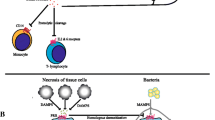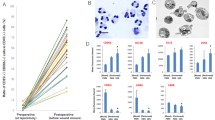Abstract
Purpose
Hepatic resections are still associated with considerable morbidity mainly because of postoperative infection. Adequate function of neutrophils is a crucial element in host defense. The aim of the study was to characterize neutrophils during partial hepatectomy.
Methods
Fourteen patients undergoing partial liver resection were enrolled. Twenty-four hours pre-, intra- (after induction of anesthesia, after preparation of the liver, and 15 min after release of the Pringle maneuver), as well as postoperatively (3 h after Pringle; 24, 48, and 120 h after surgery), blood samples were obtained. In addition, healthy volunteers (n = 5) were investigated. Adhesion molecules (CD 62, CD 18), Fcy receptors (CD 16, CD 32), and phagocytosis by neutrophils were characterized by fluorescence-activated cell sorter analysis. Spontaneous and stimulated (formyl-methionyl-leucyl-phenylalanine) oxygen radical generation was measured by lucigenin-enhanced chemiluminescence.
Results
Numeric upregulation of CD 62 and CD 18 on neutrophils was seen before the use of Pringle maneuver and persisted thereafter (p < 0.05). Spontaneous numeric expression of Fcy receptors (CD16 and CD 32) was unchanged during liver dissection but downregulated after Pringle maneuver was opened (p < 0.05). Although numeric Fcy receptors were downregulated, phagocytosis of heterologous opsonized Escherichia coli bacteria by neutrophils was unaffected. Spontaneous oxygen radical production peaked sharply 15 min after release of the Pringle maneuver (p < 0.05), contrary to stimulated oxygen radical production, which was depressed 3 h after the release of the Pringle maneuver (ns).
Conclusions
Uneventful partial hepatectomy in man resulted already in a significant change in the phenotype but in less significant changes in the functions of neutrophils.








Similar content being viewed by others
Abbreviations
- CD:
-
Cluster of differentiation
- CVP:
-
Central venous pressure
- Cpm:
-
Counts per minute
- FACScan:
-
Fluorescence-activated cell analysis
- FcyR:
-
Fc gamma receptor
- FMLP:
-
Formyl-methionyl-leucyl-phenylalanine
- Fig:
-
Figure
- HBSS:
-
Hank’s buffered salt solution
- ICAM:
-
Intercellular adhesion molecule
- MFI:
-
Mean fluorescence intensity
- PBS:
-
Phosphate buffered saline
References
Allen PJ, Jarnagin WR (2003) Current status of hepatic resection. Adv Surg 37:29–49
Jarnagin WR, Gonen M, Fong Y, DeMatteo RP, Ben-Porat L, Little S et al (2002) Improvement in perioperative outcome after hepatic resection. Analysis of 1,803 consecutive cases over the past decade. Ann Surg 4:397–407
Segal AW (2005) How neutrophils kill microbes. Annu Rev Immunol 23:197–223
Ohtsuka M, Miyazaki M, Kubosawa H, Kondo Y, Ito H, Shimizu H et al (2000) Role of neutrophils in sinusoidal endothelial cell injury after extensive hepatectomy in cholestatic rats. J Gastroenterol Hepatol 15:880–886
Strasberg SM (2005) Nomenclature of hepatic anatomy and resections: a review of the Brisbane 2000 system. J Hepatobiliary Pancreat Surg 12:351–355
Van Eeden SF, Klut ME, Walker BAM, Hogg JC (1999) The use of flow cytometry to measure neutrophil function. J Immunol Methods 232:23–43
Wiezer MJ, Meijer C, Wallast-Groenewoud HP, Tool ATJ, Prins HA, Houdijk APJ et al (1999) Impaired leukocyte phagocytosis in patients undergoing hemihepatectomy for liver metastases. Liver Transplant Surg 5:238–245
Chouker A, Martignoni A, Schauer R, Dugas M, Rau HG, Jauch KW et al (2005) Beneficial effects of ischemic preconditioning in patients undergoing hepatectomy. The role of neutrophils. Arch Surg 140:129–136
Clavien PA, Camargo CA, Gorczynski R, Washington MK, Levy GA, Langer B et al (1996) Acute reactant cytokines and neutrophil adhesion after warm ischemia in cirrhotic and noncirrhotic human livers. Hepatology 23:1456–1463
Wiezer MJ, Meijer C, Sietses C, Prins HA, Cuesta MA, Beelen RHJ et al (2000) Bactericidal/permeability—increasing protein preserves leukocyte functions after major liver resection. Ann Surg 2:208–215
Kimura F, Shimizu H, Yoshidome H, Ohtsuka M, Kato A, Yoshitomi H et al (2006) Circulating cytokines, chemokines, and stress hormones are increased in patients with organ dysfunction following liver resection. J Surg Res 133:102–112
Izycka A, Jablonska E, Izycki T, Chyczewska E (2002) Expression of adhesion molecules LFA-1 and L-selectin on PMN and level of soluble sE-selectin and sL-selectin in the serum of patients with small cell lung cancer. Pneumonol Alergol Pol 70:403–408
Cocks RA, Chan TYF, Rainer T (1998) Leukocyte L-selectin is upregulated after mechanical trauma in adults. J Trauma 45:1–6
Maekawa K, Futami S, Nishida M, Terada T, Inagawa H, Suzuki S et al (1998) Effects of trauma and sepsis on soluble L-selectin and surface expression of L-selectin and CD11b. J Trauma 44:460–468
Toledo-Pereyra LH, Lopez-Neblina F, Lentsch AB, Anaya-Prado R, Romano SJ, Ward PA (2006) Selectin inhibition modulates NF-kappa B and AP-1 signaling after liver ischemia/reperfusion. J Invest Surg 19:313–322
Shimada M, Kajiyama K, Hasegawa H, Gion T, Ikeda Y, Shirabe K et al (1998) Role of adhesion molecule expression and soluble fractions in hepatic resection. J Am Coll Surg 186:534–541
Nagarajan S, Fifadara NH, Selvaraj P et al (2005) Signal-specific activation and regulation of human neutrophil Fcy receptors. J Immunol 174:5423–5432
Carulli G, Minnucci S, Azzara A, Angiolini C, Sbrana S, Caracciolo F et al (1995) Granulocyte colony-stimulating factor (G-CSF) administration increases PMN CD 32 (FCRII) expression and FcR-related functions. Haematologica 80:150–154
Huizinga TW, van Kemenade F, Koenderman L, Dolman KM, von dem Borne AE, Tetteroo PA et al (1989) The 40-kDA Fc gamma receptor (FcRII) on human neutrophils is essential for the IgG-induced respiratory burst and IgG-induced phagocytosis. J Immunol 142:2365–2369
Fossati G, Moots RJ, Bucknall RC, Edwards SW (2002) Differntial role of neutrophil Fcy receptor IIIb (CD16) in phagocytosis, bacterial killing, and responses to immune complexes. Arthritis Rheum 46:1351–1361
Thivierge M, Parent JL, Stankova J, Rola-Pleszczynski M (1999) Modulation of formyl peptide receptor expression by IL-10 in human moncytes and neutrophils. J Immunol 162:3590–3595
Author information
Authors and Affiliations
Corresponding author
Rights and permissions
About this article
Cite this article
Holzer, K., Hofmann, D., Oppermann, E. et al. Neutrophil phenotype and function in partial hepatectomy in man. Langenbecks Arch Surg 395, 643–653 (2010). https://doi.org/10.1007/s00423-009-0557-x
Received:
Accepted:
Published:
Issue Date:
DOI: https://doi.org/10.1007/s00423-009-0557-x




